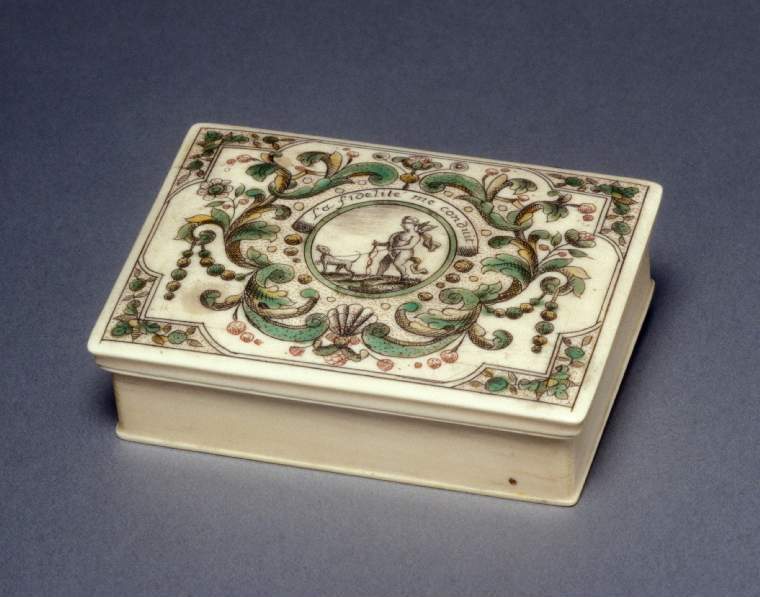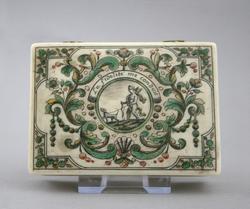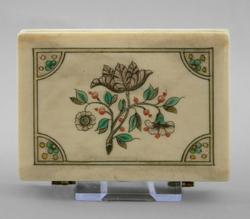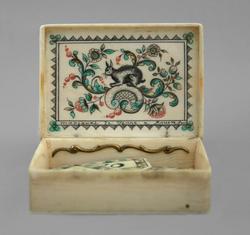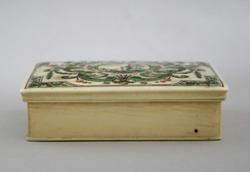Current Location: In storage
Titles
One of a set of four counter boxes
Maker(s)
Maker:
Mariaval, Le Jeune
Entities
-
Box
- counter box
- gaming token box
- boite à jettons
Categories
Description
Rectangular, ivory box painted in colours on a natural ivory ground; decorated on the lid with a circular emblem of a dog leading a blindfolded Cupid, with above, a scroll inscribed 'La fidelité me conduit'
Ivory, engraved and painted in black, green, yellow and pink, with gilt metal hinges. Rectangular, the base with straight sides. The moulded sides of the lid projecting slightly over the base. The two projecting hinges are pinned to a metal scroll inside the box. The upper surface and interior of the lid and the base are engraved in outline in black and painted on a natural ground. The top of the lid is decorated with a roundel of Cupid, blindfolded, carrying in his right hand a bow, and led by a dog on a lead.The scroll above the roundel is inscribed 'La fidelité me conduit'. The roundel is surrounded by scrolling foliage, flowers, pendant garlands and a shell in green, pink and yellow. At each corner is a swag of green fruit on a pink stippled ground.The inside the lid is decorated with a black rabbit (or cat-like creature?) surrounded by green, pink and yellow scrolling foliage and flowers within a black border beneath which is the inscription 'Mariaval le Juene a Rouen fecit'. The base is decorated with a pink and green tulip and two other flowers in a yellow border. The box contains 13 long narrow counters painted on both sides with a floral design in yellow, green and pink, and five elongated octagonal counters painted on both sides with a green and yellow floral border on a pink stipped ground, numbered in black '5', '10', '30' '40' or '50'. (with M.15 & A-Z-1938, M.16 & A-Y-1938 and M.17 & A-X-1938)
Notes
History note: Sydney Ernest Kennedy (1855-1933); Christie, Manson & Woods, 18-22 March, 1918, Catalogue of the important collection of objects of art, antiquities, armour and arms formed by S.E. Kennedy Who is giving up his residence 24 Upper Brook St WI, 5th day, on 22 March, lot ; Leonard D. Cunliffe (1878-1937)
Legal notes
L.D. Cunliffe Bequest, 1937
Measurements and weight
Height: 2.6 cm
Length: 8.5 cm
Width: 6.3 cm
Acquisition and important dates
Method of acquisition: Bequeathed
(1938-02-15)
by
Cunliffe, Leonard Daneham
Dating
18th Century, second quarter
Circa
1730
CE
-
Circa
1750
CE
Note
Mariaval le Jeune was an engraver on ivory who signed boxes in Rouen and in Paris. His dates of birth and death are unknown, but he was probably active during the second quarter of the 18th century. A box in the Victoria and Albert Museum is decorated with portrait profiles of Louis Ferdinand, Dauphin of France (1729-1765) and his second wife, Marie Josephe de Saxe (1731-1767) who did not marry until 1747. Mariaval's speciality was the production of sets of counter boxes for use in card games, which were coloured to indicate the suits in a pack of cards: red or dark pink for spades, green for diamonds, yellow for clubs and white for hearts. (See the other boxes in this set: M.15 & A-&-1938, M.16 & A-Y-1938 and M.17 & A-X-1938) They were supplied with counters of three shapes: long and narrow, elongated octagonal, and circular. None of the Fitzwilliam's boxes now include the circular counters.The Victoria & Albert Museum has a set of four boxes retaining all three shapes (W.21A/1-1985) The bpxes may have been used for reversis, an Italian card game which became popular elsewhere in western Europe during the 17th and 18th centuries.The object of the game was to avoid taking tricks, or exceptionally, to take all.
The emblem of a blindfolded Cupid being guided on a lead by a dog - a symbol of fidelity - was probably copied from emblem no. 9 on pl. XIII of Nicolas Verrien's 'Recueil d'emblêmes, devises, medailles, et figures hieroglyphiques, Au nombre de plus de douze cent, avec leurs explications . . .', Paris (Jean Jombert), 1696, or a later edition, Paris (Claude Jombert) 1724.The motto is printed in the numbered list on the following page. This was a popular emblem and also appears, for example, on a 17th century silver scissors case in the Metropolitan Museum of Art, New York (inv. no. 2014.737.1), and an 18th century boxwood snuff rasp in the Victoria & Albert Museum, (inv. no. 1417-1902).
School or Style
Rococo
People, subjects and objects depicted
Components of the work
Decoration
composed of
paint
( green, pink, yellow and black)
Ivory
Materials used in production
Ivory
Inscription or legends present
- Text: Mariaval le Jeune a Rouen fecit
- Location: Inside the lid
- Method of creation: Inscribed
- Type: Signature
- Text: La fidelité me conduit
- Location: On the lid
- Method of creation: Inscribed
- Type: Motto
Inscription present: paper label
- Text: B / 19 / L.M
- Location: On the back between the two hinges
- Method of creation: Hand-written in ink on paper
- Type: Label
Inscription present: monogram with dolphin above; and below, No. 134
- Text: SEK monogram
- Location: On back of box
- Type: Label
References and bibliographic entries
Identification numbers
Accession number: M.14 & A-R-1938
Primary reference Number: 31713
Stable URI
Audit data
Created: Saturday 6 August 2011
Updated: Tuesday 21 January 2025
Last processed: Wednesday 14 May 2025
Associated departments & institutions
Owner or interested party:
The Fitzwilliam Museum
Associated department:
Applied Arts
